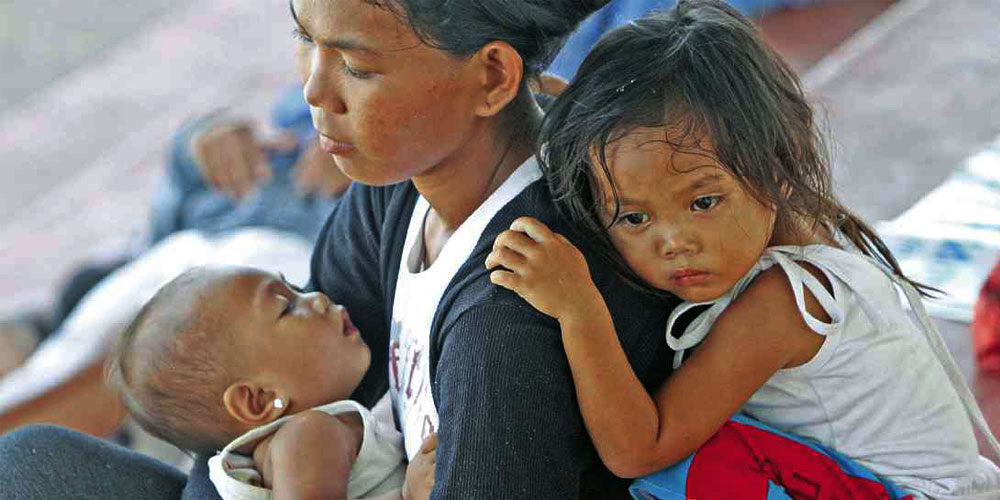Gov’t calls for more aid to Zamboanga evacuees

WAITING FOR FOOD. A woman and her two children wait for food to arrive at Joaquin F. Enriquez Memorial Sports Complex, where thousands of people have taken shelter from fighting between government forces and Moro rebels in Zamboanga City. EDWIN BACASMAS
The government has urged Filipinos to send more aid for more than 100,000 people who have fled heavy fighting between state security forces and Moro rebels in Zamboanga City, calling their plight a “humanitarian crisis.”
The conflict has claimed more than 100 lives since 200 rebels from the Moro National Liberation Front (MNLF) faction led by Nur Misuari stormed into Zamboanga City on Sept. 9 in a bid to derail peace talks between the government and a rival group, the Moro Islamic Liberation Front.
While many of the MNLF rebels have surrendered and most of the dozens of hostages they took have escaped or been freed, attention has turned to conditions faced by 118,819 people displaced by the fighting.
“This has become a humanitarian crisis,” Social Welfare Secretary Dinky Soliman told Agence France-Presse on Saturday.
Soliman said those displaced were staying in 57 evacuation centers, including the city’s main sports complex, where more than 70,000 people jostled for space and erected tents and shelters fashioned from scavenged materials.
“We are trying to organize them by providing them better materials,” she said, but appealed to the public to send in more aid in the form of clothes, food, education materials and toys for the many children among the displaced.
“The tents are very fragile. If it starts raining hard, there will be a massive problem for children, women, the elderly, the babies and their lactating mothers,” she said.
The United Nations Office for the Coordination of Humanitarian Affairs has said in a report that there was an insufficient supply of tents, cooking utensils and health and sanitation facilities.
It added that children were traumatized while immunizations for common diseases were being undertaken to prevent an outbreak.
Children’s protection
The United Nations Children’s Fund (Unicef) has provided hygiene and water kits to protect the children from diseases and tents that serve as temporary learning spaces.
But Unicef said reports indicated that more needed to be done to protect children’s rights and ensure their well-being.
The Unicef said action must be taken to prevent diseases, such as diarrhea, pneumonia and measles, and prevent malnutrition among children, including the protection and promotion of breast-feeding, and the prevention of uncontrolled procurement, acceptance, distribution and use of infant formula that increase the risk of diarrhea and malnutrition at emergency sites.
The earliest resumption of education must be ensured, along with special procedures to reduce the additional risk of neglect, abuse and exploitation of and violence against children that commonly accompany prolonged instability and insecurity, it said.
Special care and support services must be provided to children to reduce and deal with conflict-induced psychosocial problems, such as distress, depression, anxiety disorder and trauma, it added.
Registering evacuees
Soliman urged displaced people who were not staying in evacuation centers to register with the city’s Social Welfare Office to receive assistance from the government.
The Social Welfare Office has branches in the districts where the evacuees can register.
More relief goods arrived in Zamboanga City on two Philippine Coast Guard vessels on Saturday.
Cmdr. Armand Balilo, spokesperson for the Coast Guard, said the BRP Edsa and the BRP Corregidor carried rice, groceries and other relief goods sent by the Department of Social Welfare and Development (DSWD).
On Thursday, another Coast Guard vessel, the BRP Pampanga, arrived in Zamboanga City carrying rice, groceries and high-energy biscuits for the evacuees.
In a meeting with her department’s staff, Soliman gave instructions for all people in evacuation centers to be given, in addition to food and other necessities, stress debriefing to help them deal with trauma from their experience.
Soliman reported that 9,500 hygiene kits containing bath soap, detergent, a towel and a pail were given to evacuees staying in the city’s main sports complex.
The evacuees were also given eating utensils, mats and tube skirts, she said.
Red Cross meals
The DSWD has engaged local food providers and civic organizations to feed the evacuees.
The Philippine National Red Cross has also helped, providing 10,000 meals every night to augment those coming from local organizations.
Thirteen days since the fighting began, feeding the evacuees has cost more than P38 million, with the DSWD spending P35.4 million; the local government, P1 million; and private groups, P1.4 million.—Reports from AFP, Cynthia Balana and Jerry E. Esplanada














